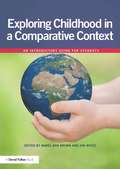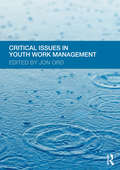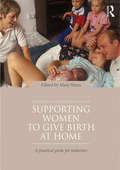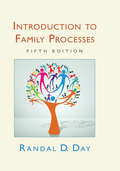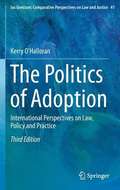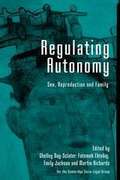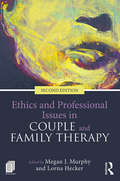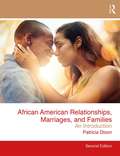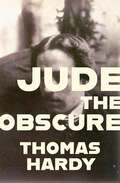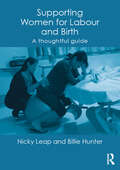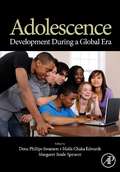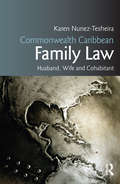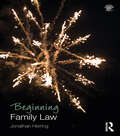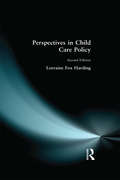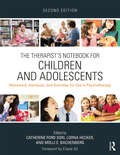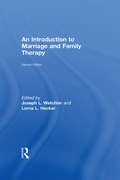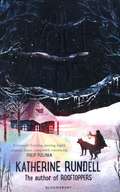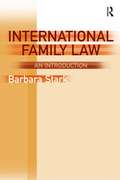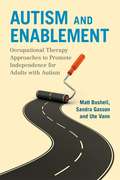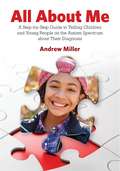- Table View
- List View
Exploring childhood in a comparative context: An introductory guide for students
by Mabel Ann Brown Jon WhiteExploring Childhood in a Comparative Context meets an increasing need for students focusing on early childhood to be familiar with alternative practices in other countries. Providing a ready-made source of information about a wide range of countries including Finland, the Netherlands, the United States, New Zealand, Japan, South Africa and many more, the book clearly describes the way each country understands and conceptualises childhood. Each chapter includes contextual information about the country, an introduction to the theory that has shaped practice and describes the curriculum for pre-school and primary education. Including vignettes from practitioners working in each country to illustrate practice, the chapters explore key themes such as: Child development Parental involvement Teaching and learning Professionalism Assessment Pupil experience. Accessibly written and including opportunities for reflection, this timely new book will give students a valuable insight into alternative education systems that is essential if they are to become practitioners with a current and global approach.
Exploring childhood in a comparative context: An introductory guide for students
by Mabel Ann Brown Jon WhiteExploring Childhood in a Comparative Context meets an increasing need for students focusing on early childhood to be familiar with alternative practices in other countries. Providing a ready-made source of information about a wide range of countries including Finland, the Netherlands, the United States, New Zealand, Japan, South Africa and many more, the book clearly describes the way each country understands and conceptualises childhood. Each chapter includes contextual information about the country, an introduction to the theory that has shaped practice and describes the curriculum for pre-school and primary education. Including vignettes from practitioners working in each country to illustrate practice, the chapters explore key themes such as: Child development Parental involvement Teaching and learning Professionalism Assessment Pupil experience. Accessibly written and including opportunities for reflection, this timely new book will give students a valuable insight into alternative education systems that is essential if they are to become practitioners with a current and global approach.
Critical Issues in Youth Work Management
by Jon OrdThis valuable textbook communicates the complexities and controversies at the heart of youth work management, exploring key issues in a critical fashion. Written by a team of experienced youth work lecturers, the chapters cover topics such as planning, evaluation and supervision, whilst acknowledging the changing structures of integrated services and the impact of public service reform. Divided into three sections, it covers: Historical and theoretical context Critical practice issues, including leadership, policy constraints, planning and accountability Managing in different settings, for instance integrated services and the voluntary sector. Aimed at both youth work students studying for their professional qualification, as well as practicing managers, Critical Issues in Youth Work Management encourages critical thinking about what management in youth work is and what it can be. It includes reflective questions and further reading, and case studies are integrated throughout.
Critical Issues in Youth Work Management
by Jon OrdThis valuable textbook communicates the complexities and controversies at the heart of youth work management, exploring key issues in a critical fashion. Written by a team of experienced youth work lecturers, the chapters cover topics such as planning, evaluation and supervision, whilst acknowledging the changing structures of integrated services and the impact of public service reform. Divided into three sections, it covers: Historical and theoretical context Critical practice issues, including leadership, policy constraints, planning and accountability Managing in different settings, for instance integrated services and the voluntary sector. Aimed at both youth work students studying for their professional qualification, as well as practicing managers, Critical Issues in Youth Work Management encourages critical thinking about what management in youth work is and what it can be. It includes reflective questions and further reading, and case studies are integrated throughout.
Supporting Women to Give Birth at Home: A Practical Guide for Midwives
by Mary SteenSupporting Women to Give Birth at Home describes and discusses the main challenges and issues that midwives and maternity services encounter when preparing for and attending a home birth. To ensure that a home birth is a real option for women, midwives need to be able to believe in a woman’s ability to give birth at home and to promote this birth option, providing evidence-based information about benefits and risks. This practical guide will help midwives to have the necessary skills, resources and confidence to support homebirth. The book includes: the present birth choices a woman has the implications homebirth has upon midwifery practice how midwives can prepare and support women and their families the midwife’s role and responsibilities national and local policies, guidelines and available resources pain management options With a range of recent home birth case studies brought together in the final chapter, this accessible text provides a valuable insight into those considering homebirth. Supporting Women to Give Birth at Home will be of interest to students studying issues around normal birth and will be an important resource for clinically based midwives, in particular community based midwives, home birth midwifery teams, independent midwives, and all who are interested in homebirth as a genuine choice.
Introduction to Family Processes: Fifth Edition
by Randal D. DayWhat goes on "behind closed doors" in families is examined in this text. Through his storytelling style, Randy Day introduces readers to the family processes approach – the strategies and behaviors families use to achieve goals. The emphasis is on how families work and interact rather than on the psychological, sociological, or economic processes. It examines emotions in families, communication, relationship formation/dissolution, family rituals, and power and conflict. Chapters open with a Preview and conclude with a Summary, Study Questions, Key Terms, and Suggested Readings. Principle Boxes highlight key concepts and a Glossary defines the key terms listed at the ends of the chapters. Significantly updated with 50% new material including many new references and examples, the new edition features: A new chapter that introduces the discipline’s methodology A new chapter on relationship formation including partner selection, falling in love, commitment, sexuality, passion, and intimacy A new design reformatted to tie in with the book’s website at http://www.psypress.com/family-processes which now contains the Chapter Activity Questions that reinforce critical thinking skills, the Journal Activities that strengthen students' personal connection to the material, and the chapter Previews and Key Terms for review purposes An Instructor’s Web Resource at http://www.psypress.com/family-processes with small group and in-class exercises, lecture outlines in PowerPoint, topics for debate, suggested films, and multiple-choice, true/false, matching, and essay questions More material on the role of gender, power, genetics, and personality in relationships; families from diverse cultural and ethnic backgrounds and the impact of work and technology on the family; the changing nature of family structures including single parenting and gay unions; and stresses in family life. Written for undergraduate courses on family processes, family dynamics, family life, the family, and/or marriage & family interaction taught in family studies, human development, psychology, sociology, social work, education, consumer sciences, home economics, health, and nursing departments, this book also appeals to those who want to maximize the positive parts of family life and manage the inevitable challenges.
Introduction to Family Processes: Fifth Edition
by Randal D. DayWhat goes on "behind closed doors" in families is examined in this text. Through his storytelling style, Randy Day introduces readers to the family processes approach – the strategies and behaviors families use to achieve goals. The emphasis is on how families work and interact rather than on the psychological, sociological, or economic processes. It examines emotions in families, communication, relationship formation/dissolution, family rituals, and power and conflict. Chapters open with a Preview and conclude with a Summary, Study Questions, Key Terms, and Suggested Readings. Principle Boxes highlight key concepts and a Glossary defines the key terms listed at the ends of the chapters. Significantly updated with 50% new material including many new references and examples, the new edition features: A new chapter that introduces the discipline’s methodology A new chapter on relationship formation including partner selection, falling in love, commitment, sexuality, passion, and intimacy A new design reformatted to tie in with the book’s website at http://www.psypress.com/family-processes which now contains the Chapter Activity Questions that reinforce critical thinking skills, the Journal Activities that strengthen students' personal connection to the material, and the chapter Previews and Key Terms for review purposes An Instructor’s Web Resource at http://www.psypress.com/family-processes with small group and in-class exercises, lecture outlines in PowerPoint, topics for debate, suggested films, and multiple-choice, true/false, matching, and essay questions More material on the role of gender, power, genetics, and personality in relationships; families from diverse cultural and ethnic backgrounds and the impact of work and technology on the family; the changing nature of family structures including single parenting and gay unions; and stresses in family life. Written for undergraduate courses on family processes, family dynamics, family life, the family, and/or marriage & family interaction taught in family studies, human development, psychology, sociology, social work, education, consumer sciences, home economics, health, and nursing departments, this book also appeals to those who want to maximize the positive parts of family life and manage the inevitable challenges.
The Politics Of Adoption: International Perspectives On Law, Policy And Practice (PDF)
by Kerry O'HalloranThis book explains, compares and evaluates the social and legal functions of adoption within a range of selected jurisdictions and on an international basis. It updates and extends the second edition published by Springer in 2009. From a standpoint of the development of adoption in England & Wales and the changes currently taking place there, it considers the process as it has evolved in other countries. It identifies themes of commonality and difference in the experience of adoption in a common law context as compared and contrasted with that of other countries. It looks at adoption in France, Sweden and other civil law countries, as well as Japan and elsewhere in Asia, including a focus on Islamic adoption. It examines the experience of indigenous people in New Zealand and Australia, contrasting the highly regulated legal process of modern western society with the traditional practice of indigenous communities such as the Maori. A new chapter studies adoption in China. The book uses the international Conventions and associated ECtHR case law to benchmark developments in national law, policy and practice and to facilitate a cross-cultural comparative analysis.
Regulating Autonomy: Sex, Reproduction And Family (PDF)
by Shelley Day-Sclater Fatemeh Ebtehaj Emily Jackson Martin RichardsThese essays explore the nature and limits of individual autonomy in law, policy and the work of regulatory agencies. Authors ask searching questions about the nature and scope of the regulation of 'private' lives, from intimacies, personal relationships and domestic lives to reproduction. They question the extent to which the law does, or should, protect individual autonomy. Recent rapid advances in the development of new technologies - particularly those concerned with human genetics and assisted reproduction - have generated new questions (practical, social, legal and ethical) about how far the state should intervene in individual decision making. Is there an inevitable tension between individual liberty and the common good? How might a workable balance between the public and the private be struck? How, indeed, should we think about 'autonomy'?The essays explore the arguments used to create and maintain the boundaries of autonomy - for example, the protection of the vulnerable, public goods of various kinds, and the maintenance of tradition and respect for cultural practices. Contributors address how those boundaries should be drawn and interventions justified. How are contemporary ethical debates about autonomy constructed, and what principles do they embody? What happens when those principles become manifest in law?
Ethics and Professional Issues in Couple and Family Therapy
by Megan J. Murphy Lorna HeckerEthics and Professional Issues in Couple and Family Therapy, Second Edition builds upon the strong foundations of the first edition. This new edition addresses the 2015 AAMFT Code of Ethics as well as other professional organizations’ codes of ethics, and includes three new chapters: one on in-home family therapy, a common method of providing therapy to clients, particularly those involved with child protective services; one chapter on HIPAA and HITECH Regulations that practicing therapists need to know; and one chapter on professional issues, in which topics such as advertising, professional identity, supervision, and research ethics are addressed. This book is intended as a training text for students studying to be marriage and family therapists.
African American Relationships, Marriages, and Families: An Introduction
by Patricia DixonAfrican American Relationships, Marriages, and Families, Second Edition is a historically and culturally centered research-based text designed for use in undergraduate, graduate, and community-based courses on African American relationships, marriages, and families. Complete with numerous exercises, this volume can be used by current and future helping professionals to guide singles and couples by increasing single and partner-awareness, and respect and appreciation for difference. In addition, singles and couples learn skills for effective communication and conflict resolution and ultimately how to develop and maintain healthy relationships, marriages, and families. This second edition includes updates and revisions to current chapters and also features two new chapters: one on parenting and one on same-gender loving/LGBTQ.
African American Relationships, Marriages, and Families: An Introduction
by Patricia DixonAfrican American Relationships, Marriages, and Families, Second Edition is a historically and culturally centered research-based text designed for use in undergraduate, graduate, and community-based courses on African American relationships, marriages, and families. Complete with numerous exercises, this volume can be used by current and future helping professionals to guide singles and couples by increasing single and partner-awareness, and respect and appreciation for difference. In addition, singles and couples learn skills for effective communication and conflict resolution and ultimately how to develop and maintain healthy relationships, marriages, and families. This second edition includes updates and revisions to current chapters and also features two new chapters: one on parenting and one on same-gender loving/LGBTQ.
Jude the Obscure
by Thomas HardyPowerful and controversial from its 1895 publication to the present, Jude the Obscure scandalized Victorian critics, who condemned it as decadent, indecent, and degenerate. Between its frank portrayals of sexuality and its indictments of marriage, religion, and England's class system, the novel offended a broad swath of readers. Its heated reception led the embittered author to renounce fiction, turning his considerable talents ever afterward to writing poetry.Hardy's last novel depicts a changing world, where a poor stonemason can aspire to a university education and a higher place in society--but where in reality such dreams remain unattainable. Thwarted at every turn, Jude Hawley abandons his hopes, is trapped into an unwise marriage, and pursues a doomed relationship with his free-spirited cousin, Sue Bridehead. The lovers find themselves equally incapable of living within the conventions of their era and of transcending its legal and moral strictures. Hailed by modern critics as a pioneering work of feminism and socialist thought, Hardy's tragic parable continues to resonate with readers.
Supporting Women for Labour and Birth: A Thoughtful Guide
by Billie Hunter Nicky LeapFear of childbirth, the increasing use of epidurals and soaring caesarean section rates are the focus of much apprehension, debate, and controversy in contemporary maternity care. Across the world, support in labour has been shown to reduce obstetric interventions and improve outcomes for women and babies, yet women often report feeling unhappy with the support they receive. This textbook provides a clear and practical guide to supporting women in labour, looking at a range of techniques and approaches that promote a safe and positive experience of birth for women and their families. ? Written by two highly experienced midwifery authors, this text draws on up-to-date research, identifying how evidence can be applied to everyday practice. It includes narratives from women and practitioners, including midwives, doulas, childbirth educators and students. These are used to illustrate a range of situations where the quality of support is central to the quality of the experience and outcome. Supporting Women for Labour and Birth encourages readers to reflect on their experiences and examine the evidence provided by both research and the experiences of women and practitioners in order to explore how this could be incorporated into their practice.? The only book to deal directly with the practical and emotional issues associated with labour support, it is an ideal text for student midwives and an important reference for practising midwives, doulas and other childbirth practitioners.
Adolescence: Development During A Global Era (PDF)
by Dena Phillips Swanson Malik Chaka Edwards Margaret Beale SpencerThis edited textbook will be appropriate for use in advanced undergraduate and graduate level courses and will serve as a comprehensive and timely introduction to the field of adolescent development, providing students with a strong foundation for understanding the biological, cognitive and psychosocial transitions occurring during adolescence. While certain normative biological and cognitive processes are relevant for all youth, development varies dramatically based on a youth's position in society. The volume will focus on contextual factors such as culture, racial identity, socioeconomic position and sociopolitical and historical events, highlighting the impact such factors have on the physiological and psychological processes and treating them as key elements in understanding development during this life stage. The authors will cover the major theoretical positions (both historical and contemporary) about adolescence as well as the relevant research and application. Additionally, modern phenomena - the ever-increasing influence of pop culture (i. e. Hip Hop), mass media and technology (i. e. , the internet, gaming) and the evolution of family, education and the church - will be explored in depth. Each chapter will be written by a known expert in the field. More extensive analysis of cultural, political and socioeconomic factors impacting development than competing texts Research-to-Practice section covers evidence-based research on practice implementation
Commonwealth Caribbean Family Law: husband, wife and cohabitant (Commonwealth Caribbean Law)
by Karen TesheiraThis important new text is the product of several years of research of the family law of fifteen Commonwealth Caribbean jurisdictions. It is the first and only legal text that comprehensively covers all the main substantive areas of spousal family law, including marriage, divorce, financial support, property rights and domestic violence. The rights of the statutory spouse in the jurisdictions of Barbados, Belize, Guyana, Jamaica, and Trinidad and Tobago are examined, thus addressing, on a jurisdictional basis, an important area of spousal family that is seldom covered in English family law texts. The book also covers the number and variations of divorce regimes applicable to the region – the matrimonial offence divorce model of Guyana and Montserrat, the English five fact model of Trinidad and Tobago, Dominica, Grenada, Anguilla, and St Vincent and the Grenadines, the hybrid model of Antigua and Barbuda, Belize and St Kitts and Nevis, and the no fault model of Jamaica and Barbados. This book will prove an indispensable resource for law students and legal academics, as well as for family law practitioners across the English-speaking Caribbean. Other professionals, including sociologists and social workers, will also find the book useful and informative.
Beginning Family Law (Beginning the Law)
by Jonathan HerringWhether you’re new to higher education, coming to legal study for the first time or just wondering what Family Law is all about, Beginning Family Law is the ideal introduction to help you hit the ground running. Starting with the basics and an overview of each topic, it will help you come to terms with the structure, themes and issues of the subject so that you can begin your Family Law module with confidence. Adopting a clear and simple approach with legal vocabulary carefully clarified, Jonathan Herring breaks the subject of family law down using practical everyday examples to make it understandable for anyone, whatever their background. Diagrams and flowcharts simplify complex issues, important cases are identified and explained and on-the- spot questions help you recognise potential issues or debates within the law so that you can contribute in classes with confidence. Beginning Family Law is an ideal first introduction to the subject for LLB, GDL or ILEX and especially international students, those enrolled on distance learning courses or on other degree programmes. Visit the companion website: http://www.routledge.com/cw/beginningthelaw/
Perspectives in Child Care Policy
by Lorraine Fox HardingChild care law and policy issues generate very strong emotions and some crucial questions concerning the role of the state. For instance, under what circumstances should the state be able to intervene and use the force of the law to protect children? Do children have similar rights to adults? Such questions are matters of controversial debate and, in the light of well publicised child abuse cases, official inquiries and a government review led to the passing of the Children Act in 1989.Perspectives in Child Care Policy presents four different value perspectives on child care policy - laissez-faire; state paternalism; defence of the birth family and children's rights. These perspectives differ in their underlying values, concepts and assumptions concerning children, families, the rights and powers of parents and the role of the state.
The Therapist's Notebook for Children and Adolescents: Homework, Handouts, and Activities for Use in Psychotherapy
by Lorna Hecker Catherine Ford Sori Molli E. BachenbergIn The Therapist's Notebook for Children and Adolescents, 2nd ed, you'll find the most powerful tools available for aiding children with their feelings, incorporating play techniques into therapy, encouraging appropriate parental involvement in family sessions, and providing group therapy to children. This ready reference is divided into ten thoughtfully planned sections to make it easy to find the right activity, handout, or intervention for the problem at hand, whether you’re looking for creative ideas, running a children’s group, putting interventions into practice in the classroom, or looking for ways to increase parental and familial involvement. Instructions for the activities are clearly explained and highlighted with case examples and many illustrations. Chapters are by leading experts, including Eliana Gil, Risë VanFleet, Liana Lowenstein, Howard Rosenthal, and Volker Thomas, and explore strategies for treating children both individually and in a family context. With more than 60% new material, this expanded version delves into the latest research and thinking on family play therapy and addresses many pertinent issues of our time, including bullying, suicidal ideation, ADHD, autism, adolescents and sex, and cultural issues. It’s a must-have arsenal for both novice and experienced professionals in family therapy, play therapy, psychology, psychiatry, counseling, education, nursing, and related fields.
An Introduction to Marriage and Family Therapy
by Joseph L. Wetchler Lorna L. HeckerNow in its second edition, this text introduces readers to the rich history and practice of Marriage and Family Therapy, with 32 professionals from across the US presenting their knowledge in their areas of expertise. This blend of approaches and styles gives this text a unique voice and makes it a comprehensive resource for graduate students taking their first course in Marriage and Family Therapy. The book is divided into three sections: Part 1 focuses on the components on which 21st century family therapy is based and summarizes the most recent changes made to not only therapeutic interventions, but to the very concept of “family.” Part 2 presents an overview of the 7 major theoretical models of the field: structural, strategic, Milan, social constructionist, experiential, transgenerational, and cognitive-behavioral family therapy. Each chapter in this section • Focuses on the founder of the theory, its theoretical tenants, and its key techniques• Shows how the model focuses on diversity• Presents the research that supports the approach Part 3 addresses specific treatment areas that are common to marriage and family therapists, such as sex therapy, pre-marital therapy, research, and ethics and legal issues. As an introduction to the field of Marriage and Family Therapy, this volume stands above the rest. Not only will readers gain an understanding of the rich history of the field and its techniques, but they will also see a complete picture of the context in which families are embedded, such as gender, culture, spirituality, and sexual orientation. This knowledge is the key to understanding what differentiates Marriage and Family Therapy from individual psychotherapy. Glossaries, case studies, tables, figures, and appendices appear generously throughout the text to present this information and give students a thorough overview to prepare them for their professional lives.
An Introduction to Marriage and Family Therapy
by Joseph L. Wetchler Lorna L. HeckerNow in its second edition, this text introduces readers to the rich history and practice of Marriage and Family Therapy, with 32 professionals from across the US presenting their knowledge in their areas of expertise. This blend of approaches and styles gives this text a unique voice and makes it a comprehensive resource for graduate students taking their first course in Marriage and Family Therapy. The book is divided into three sections: Part 1 focuses on the components on which 21st century family therapy is based and summarizes the most recent changes made to not only therapeutic interventions, but to the very concept of “family.” Part 2 presents an overview of the 7 major theoretical models of the field: structural, strategic, Milan, social constructionist, experiential, transgenerational, and cognitive-behavioral family therapy. Each chapter in this section • Focuses on the founder of the theory, its theoretical tenants, and its key techniques• Shows how the model focuses on diversity• Presents the research that supports the approach Part 3 addresses specific treatment areas that are common to marriage and family therapists, such as sex therapy, pre-marital therapy, research, and ethics and legal issues. As an introduction to the field of Marriage and Family Therapy, this volume stands above the rest. Not only will readers gain an understanding of the rich history of the field and its techniques, but they will also see a complete picture of the context in which families are embedded, such as gender, culture, spirituality, and sexual orientation. This knowledge is the key to understanding what differentiates Marriage and Family Therapy from individual psychotherapy. Glossaries, case studies, tables, figures, and appendices appear generously throughout the text to present this information and give students a thorough overview to prepare them for their professional lives.
The Wolf Wilder (PDF)
by Katherine Rundell Gelrev OngbicoFeodora and her mother live in the snowbound woods of Russia, in a house full of food and fireplaces. Ten minutes away, in a ruined chapel, lives a pack of wolves. Feodora's mother is a wolf wilder, and Feo is a wolf wilder in training. A wolf wilder is the opposite of an animal tamer: it is a person who teaches tamed animals to fend for themselves, and to fight and to run, and to be wary of humans. When the murderous hostility of the Russian Army threatens her very existence, Feo is left with no option but to go on the run. What follows is a story of revolution and adventure, about standing up for the things you love and fighting back. And, of course, wolves.
International Family Law: An Introduction
by Barbara StarkInternational law has become part of everyday family law practice, as lawyers everywhere are confronted with questions regarding the rights of 'mail-order' brides, the adoption of children from other countries, the abduction of children by foreign parents, and domestic violence victims seeking asylum. Indeed, globalization is transforming family law, even as families themselves are being redefined. This book provides a practical overview of such issues and also examines the ways in which culture shapes family law in different countries. It provides students with a useful introduction to challenging, complicated and fascinating issues in international family law. Finally, by incorporating a comparative perspective, it gives readers an opportunity to re-examine their own legal systems.
Autism and Enablement: Occupational Therapy Approaches to Promote Independence for Adults with Autism (PDF)
by Matt Bushell Sandra Gasson Ute VannAdults with Autism Spectrum Conditions (ASC) or a suspected diagnosis often have hidden needs that go unmet by public services. This book describes and analyses the Kent ASC enablement approach, a short-term intervention led by occupational therapy to promote people with ASC becoming more self-aware and self-sufficient outside of public services. Designed to teach adults with ASC strategies for controlling their sensory, motor-processing and social-communication needs and preferences, this person-centred approach gives them greater self-management over their lives. The book also provides an overview of a range of both professional and self-help tools and technologies which can be used by adults with ASC to increase independence and wellbeing. Case-studies demonstrate the transformative effects of enablement on daily life for adults with ASC. The book also provides recommendation for building on the enablement approach.
All About Me: A Step-by-Step Guide to Telling Children and Young People on the Autism Spectrum about Their Diagnosis (PDF)
by Andrew MillerBased on direct work with over 250 individual children, Andrew Miller wrote this book in order to provide parents and professionals with information, tools and guidance to help introduce children to autism in the absence of specialist support. This in-depth guide describes the practicalities of disclosure, including when to tell, who should do it and what they need to know beforehand with strategies to tailor your approach as every child's experience will be different. Step-by-step instructions detail how to deliver the programme and produce with a child a personalised booklet containing information about their personal attributes and their autism. These booklets and follow-up material help make disclosure a positive and constructive experience for everyone. Accompanying material can be downloaded online including questionnaires, examples of children's booklets and flexible templates.
